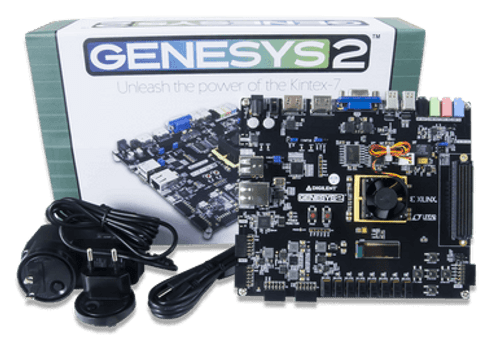The Basys 3 is one of the best boards on the market for getting started with FPGA. It is an entry-level development board built around a Xilinx Artix-7 FPGA.
As a complete and ready-to use digital circuit development platform, it includes enough switches, LEDs, and other I/O devices to allow a large number of designs to be completed without the need for any additional hardware. There are also enough uncommitted FPGA I/O pins to allow designs to be expanded using Digilent Pmods or other custom boards and circuits, and all of this at a student-friendly price point.
The Basys 3 is designed exclusively for Xilinx’s Vivado Design Suite, and the WebPACK edition is available as a free download from Xilinx.
Guides and demos are available to help users get started quickly with the Basys 3. These can be found through the Support Materials tab.
- Features the Xilinx Artix-7 FPGA: XC7A35T-1CPG236C
- 33,280 logic cells in 5200 slices (each slice contains four 6-input LUTs and 8 flip-flops)
- 1,800 Kbits of fast block RAM
- Five clock management tiles, each with a phase-locked loop (PLL)
- 90 DSP slices
- Internal clock speeds exceeding 450 MHz
- On-chip analog-to-digital converter (XADC)
- Digilent USB-JTAG port for FPGA programming and communication
- Serial Flash
- USB-UART Bridge
- 12-bit VGA output
- USB HID Host for mice, keyboards and memory sticks
- 16 user switches
- 16 user LEDs
- 5 user pushbuttons
- 4-digit 7-segment display
- 4 Pmod ports: 3 Standard 12-pin Pmod ports, 1 dual purpose XADC signal / standard Pmod port
- Micro-B USB cable not included, but can be added for free with your Basys 3!
- Basys 3 FPGA development board
- Receive a free USB A to Micro-B cable with your Basys 3 purchase! (Must have the USB cable and Basys 3 in your cart for the discount).
- Custom Digilent cardboard box with protective foam
The Basys 3 can be programmed with Digilent's Adept software. Digilent Adept is a unique and powerful solution which allows you to communicate with Digilent system boards and a wide assortment of logic devices. Find out more about Adept here.
To create and modify designs for your Basys 3, you can use Xilinx's Vivado Design Suite. Vivado is a software designed for the synthesis and analysis of HDL designs. The Basys 3 is supported by the free WebPACK edition of the Vivado Design Suite.
Note: Xilinx software tools are not available for download in some countries. Prior to purchasing the Basys 3, please check the supporting software's availability, as it is required for the board's use.
Quickly find what you need to get started and reduce mean time to blink.
All product support including documentation, projects, and the Digilent Forum can be accessed through the product resource center.
Resource Center










